Since we purchased the Sony A7r II for our in-depth analysis, I have had the chance to test the camera with many different lenses including third-party DSLR lenses. There are two main reasons behind testing non-native E-mount glass. First, it was part of my in-depth autofocus test where I came to quite a positive conclusion. The second is a consequence of the first reason: I wanted to find out if some of these lenses could be integrated into a mirrorless system despite not being designed for Sony cameras in the first place.
The Sony A7r mark II has many interesting aspects but as with every mirrorless system, size and weight remain the two primary benefits. This is where the first obstacle appears: most DSLR lenses are larger and heavier and they can unbalance the small A7r II body. Can some specific lenses be worth it anyway? In my opinion, yes, but only up to a certain point.
You might ask why Sigma instead of Canon, Nikon or even Tamron lenses?
The first argument is very simple: Sigma UK has been very collaborative in sending us various samples. The second reason is that Sigma lenses are a good mix between an affordable price and excellent optical quality. This is especially true in the case of the Art series. I do not own any DLSR lenses and the only reason I’d consider one would be to fill a gap while waiting for more native FE lenses to show up. So I would not want to spend too much money knowing that I wouldn’t keep the lens forever.
In this article, you will find my impressions of the various Sigma lenses I’ve tried so far with the A7r mark II. I chose what to test by following a certain logic. First it had to be a focal length that is currently not available as a native FE lens or that has a significant advantage over the Sony E-mount equivalent. For example I excluded the 50mm Art because nothing beats the FE 55mm f/1.8 for both its optical quality and small size. The difference in price is not big and if I include the cheapest adapter, then the 55mm is on par.
Please also note that this article isn’t a definitive guide but rather a personal and “work-in-progress” feedback. I couldn’t test the camera with every lens mount version or with every adapter available. Therefore not all the conclusions about each lens are definitive.
Introduction: choosing the adapter and mount version
I’ve already said it but I’ll repeat it here as well: these lenses are not designed for the A7r II and need an adapter to work. This means that there are three different parts made by two or three different manufacturers working together. The results won’t be perfect. The autofocus won’t be perfect. Even if an adapter works well with a specific EF-mount lens, this doesn’t mean it will work well with all EF lenses. Actually, some lenses won’t work at all. In my experience, the only tangible thing I noticed is that the most recent lenses tend to behave better concerning the AF performance.
First, there is the question of which mount to choose: Sony A, Canon EF or Nikon F?
I’ll exclude Nikon because as of now, only one adapter (made by Commlite) with Phase Detection AF support is available. It was released recently which means that there isn’t a lot of feedback about its performance yet.
Choosing the Sony A-mount version could seem the most logical choice. However not every Sigma lens has an A-mount option, especially the latest products. I can also add that overall I didn’t notice a substantial difference concerning the AF speed when using A-mount lenses instead of EF lenses. The Sony LA-EA3 adapter is good but it is not perfect. More than once the camera switched to MF and I had to unmount/mount the adapter to fix the problem. So the logic that “Sony with Sony should work better” isn’t necessarily true.
That leaves us with the Canon EF-mount version. They are simply easier to hire while A-mount lenses are harder to find even in most camera shops. Usually you need to order them at the shop itself or online (note that this can vary from country to country).
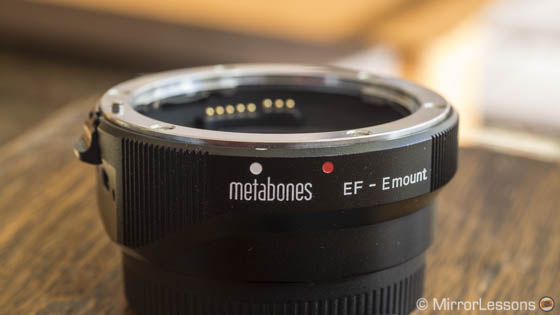
Update: one of the best adapter you can find now is the Sigma MC-11. You can check out our review here.
Concerning EF-mount adapters, the Metabones EF to E Mount Smart Adapter Mark IV is the best option. No surprises here, everyone has pretty much come to the same conclusion. I hired it while working on my in-depth autofocus article with the A7r II. It has the most precise build quality, the most accurate AF results and can be updated via firmware to improve its performance. The only downside is the very expensive price tag (almost $400). This is why I didn’t purchase it personally. I couldn’t justify such a cost while not being sure if I would ever consider buying one of these lenses anyway. The Commlite and Viltrox weren’t available at the time so I turned to the Fotodiox Pro EF-Nex Auto. It is not perfect as you will see below but was enough for me to get an idea of what you can do with these lenses on the A7r II.
Sigma 20mm f/1.4 DG HSM Art

I was mainly interested in testing this lens for astrophotography since it is the world’s fastest 20mm lens. It is large and heavy but for this genre it would be the only lens I’d carry in my bag and I would use a tripod all the time. The AF is very fast and reliable, and sharpness at the centre is already stunning from 1.4. The bokeh as well as the capacity to separate the subject from the background are extremely good despite the focal length being so short.



Unfortunately as of now my conclusion isn’t positive. While the lens seems to perform really well on a Nikon or Canon camera, with the A7r mark II you get significant field curvature which isn’t really interesting for astrophotography. I couldn’t test it with another adapter so it could be that sharpness improves with the Metabones Mark IV. But at the same time, this is the only wide angle lens that gave me such a noticeable problem with the Fotodiox Pro. This just shows how things can vary from lens to lens, and how difficult it can be to find the optimal combination (if there is one).
- What works: AF is fast and accurate, sharpness at the centre is stunning
- What doesn’t work: field curvature is pronounced
- Benefit of the doubt: performance could improve with the Metabones Mark IV concerning sharpness at the corners
- A-mount version: not available.
- Any native FE lens as an alternative?: none
Sigma 24mm f/1.4 DG HSM Art

This is my favourite lens so far. The Nikkor 24mm f/1.4 AF-S was one of my go-to lenses when I had my Nikon D700 and I was very pleased to try a new 24mm 1.4 on a full frame sensor. It isn’t too large or heavy which means that the ergonomics with the camera remain acceptable. The AF is fast and accurate, probably the best I’ve tried out of all the lenses in this article. It works well in good light, low light and backlit situations even with the Fotodiox Pro.
The optical quality is really surprising, from the sharpness at f/1.4 to the quality of the bokeh and how the lens can separate the subject from the background (even with a full body shot). The 24mm can suffer from large and circular lens flares but I find them interesting, actually! With the Fotodiox Pro, the only negative aspect is some internal reflection in strong and direct backlit situations.



The only doubt I have about the 24mm has to do with the native Zeiss Batis 25mm f/2. Granted, 1mm on a wide angle lens makes some difference and you lose 1 stop of light. However the Batis lens’ performance is as good as the Sigma in many ways. It really becomes a matter of precise specs (f/1.4 vs f/2 mainly) and the price. The Batis is more expensive even including a Fotodiox or Commlite adaptor for the Sigma. Right now the Batis isn’t so easy to find either.
- What works: AF is fast and accurate, optical quality is excellent, size and weight is more than acceptable.
- What doesn’t work: some internal reflections appearing at the extreme corners in backlit situations but that is certainly due to the Fotodiox Pro adapter.
- A-mount version: not available.
- Any native FE lens as an alternative?: The Zeiss Batis 25mm f/2 is the closest you can find for now (full review here).
Sigma 35mm f/1.4 DH HSM Art
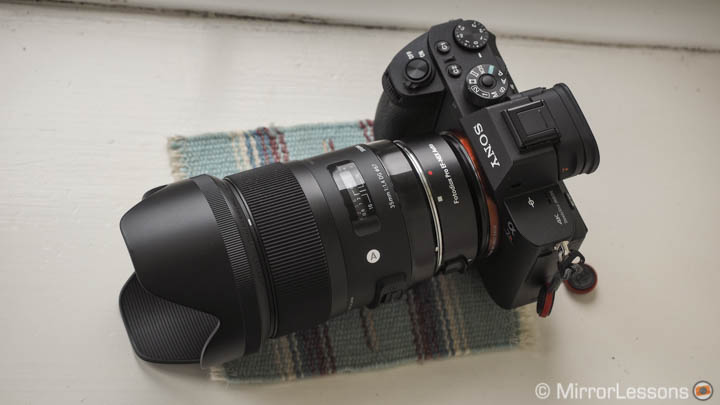
The only reason I wanted to test this lens was to see if it could be an interesting alternative to the native FE 35mm f/1.4 Distagon lens. The latter is excellent when it comes to optical quality but is also the most expensive FE lens you can find right now (more than $1500). It has something more when it comes to pure optical performance but the Sigma Art 35mm is an excellent alternative. With the adapter it doesn’t look much larger because the FE 35mm is also one of the largest and bulkiest native lenses you can find.


The best AF performance is with the Metabones mark IV so that is another cost to take into account. Also if you are looking for a fast 35mm lens to use every day for professional work, the Zeiss Distagon might be a safer bet. After all, an adapter in the way can sometimes give you a hard time when you least expect it.
- What works: Even by adding the adapter’s cost, it remains cheaper than the FE 35mm f/1.4 with similar size/weight. Optical performance is really good.
- To consider: Works best with the Metabones Mark IV.
- A-mount version: Available. According to multiple hands-on reports (here, here and here for example), it works well with the A7r II.
- Any native FE lens as an alternative?: The Sony Distagon 35mm f/1.4 ZA. For daily work, it could prove a more reliable long-term investment. If you shoot video, it has a de-clicking aperture option.
Sigma 24-105mm f/4 DG OS HSM Art
[twentytwenty]


[/twentytwenty]
The native FE 24-70mm f/4 received many mixed reviews and I wasn’t that impressed when I tried it myself. When it comes to f/4 zoom lenses, why not have a more versatile range of focal lengths? This is why the Sigma 24-105mm Art could prove an interesting alternative. Here again the size and weight don’t unbalanced the combo too much but you definitely feel the weight a little more in comparison to the 24mm and 35mm primes.



The AF is fast and reliable even with the Fotodiox Pro but slower than some Art prime lenses. The optical quality is good but I admit that in the end this lens didn’t impress me as much as I thought it could. The optical stabilisation works well in conjunction with the A7r II’s 5-axis stabilisation. I personally think it is worth it if you already own an adapter and can therefore save some money versus buying the FE 24-70mm f/4.
- What works: AF is fast and accurate, OIS works fine and optical performance is rather good.
- What doesn’t work: it feels a little bit heavy on the A7r II body
- A-mount version: Available. According to Brian Smith it works well but I haven’t found other relevant reports. “Try before you buy” (if possible).
- Any native FE lens as an alternative?: The Sony Vario-Tessar T FE 24-70mm f/4 ZA OSS is the closest choice.
Sigma APO 70-200mm F2.8 EX DG OS HSM
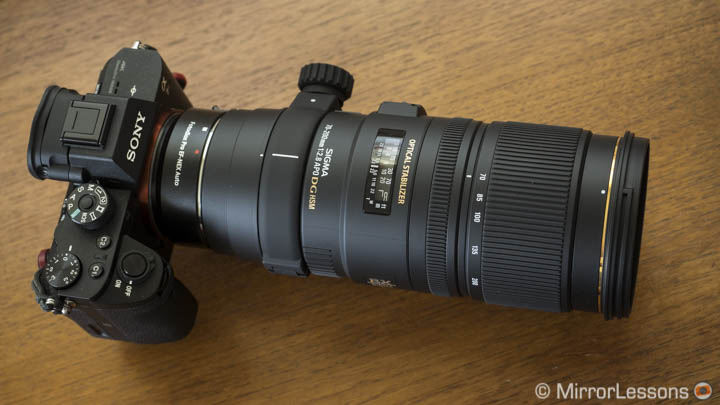
There are currently no f/2.8 constant aperture zoom lenses available in the FE catalogue. There are rumours about Sony releasing them next year but in the meantime we have to choose either the f/4 zoom lenses or adapt another one. Here again the Sigma 70-200mm f/2.8 could seem like a good alternative. It is not excessively large and heavy for a 2.8 telephoto zoom and offers good optical performance at a very reasonable price.

Unfortunately the AF doesn’t work with any of the EF to E adapters (not even the Metabones Mark IV). I used it one night only at a concert, relying on manual focus and a monopod because my subjects were static. It proved interesting for video shooting as well. That said, I wouldn’t invest money in it knowing that the AF is not reliable.
- What works: Good optical quality and affordable price.
- What doesn’t work: AF doesn’t work with any EF-mount adapter.
- A-mount version: Available. However according to a few short reports found on the web, it doesn’t seem to work well.
- Any native FE lens as an alternative?: The Sony 70-200mm f/4 G OSS. It is a lens I really like for its compact size and very good performance.
Sigma 85mm f/1.4 EX DG HSM
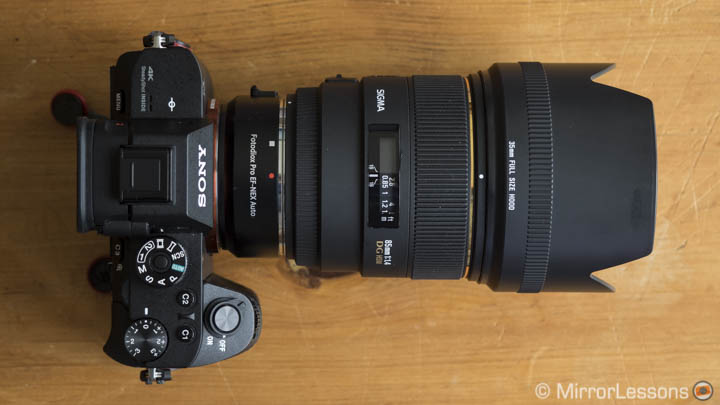
Perhaps one of the lenses that photographers are missing the most right now in the E-mount line-up is a fast portrait lens. Zeiss answered that with the excellent Batis 1.8/85 but many users aren’t convinced by the price of the lens considering it is “only” a f/1.8 lens. Fortunately there are many options when it comes to good portrait lenses. The Sigma 85mm 1.4 is one of them and once again it has the advantage of being affordable. Sharpness at f/1.4 is good and you can get a very shallow and creamy depth of field from your portraits.



The autofocus was problematic with the Fotodiox but works better with the Metabones Mark IV so once again the most expensive adapter needs to be included in the final bill.
- What works: Good optical quality and affordable price.
- To consider: AF works well with the Metabones Mark IV only.
- A-mount version: Available. AF seems to work but isn’t the fastest according to different reports (works in micro steps according to Mike Kobal).
- Any native FE lens as an alternative?: The Zeiss Batis 85mm f/1.8. Even if is only a 1.8 lens, I consider it one of the best I’ve ever tried (my full review here). However it is more expensive.
Sigma 150mm f/2.8 Macro

Sony added a stunning macro lens to its FE catalogue: the 90mm Macro f/2.8 G. However if you need more telephoto reach, Sigma has the 150mm and 180mm macro lenses in its catalogue. The latter is considered one of the best macro lenses ever made but it is also very heavy, large and expensive. The 150mm is a more balanced solution for the A7r II and also less expensive. Unfortunately here as well the autofocus is not reliable. It occasionally focuses but it is really slow. Most of the time the lens will simply hunt back and forth and never lock. Also the OIS created some communication problems with the adapter and the camera.


However this can be less of a problem because for macro photography you often need to rely on manual focus and use a tripod. I would consider this lens if you can find a good second-hand deal.
- What works: Good optical quality and acceptable size/weight
- What doesn’t work: AF and OIS are unreliable
- A-mount version: Available. According to Brian Smith, it works well. Again, “trying before buying” is advised if possible.
- Any native FE lens as an alternative?: The Sony 90mm f/2.8 Macro G OSS. If the extra 60mm aren’t necessary, this is currently one of the best lenses for the FE system and works well for portraits too.
Sigma 150-600mm f/5-6.3 C
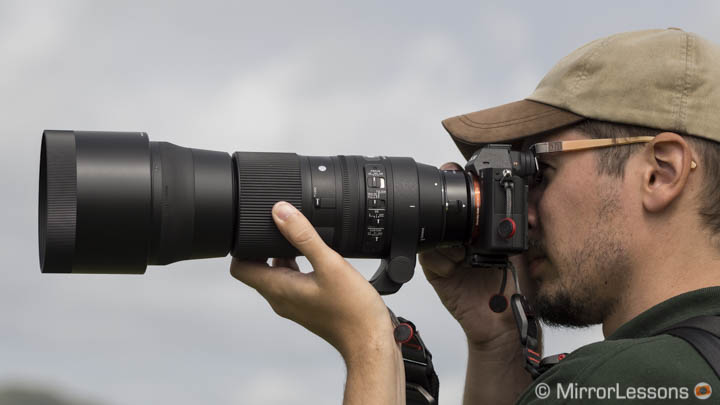
After the 24mm f/1.4 Art, this is the second lens I enjoyed the most on the A7r II. I chose the Contemporary version instead of the Sport version because the former is smaller, lighter and easier to use on the smaller A7r II body. With the Metabones Mark IV I got very good results in terms of autofocus performance. It is not perfect as I detailed in the article here but can be a good choice if you need an extreme telephoto lens while waiting for something better from the native E-mount.


The optical performance is not bad at all and you get decent sharpness even at the longest focal length. Note however that past 500mm, you can end up with some misfocused shots more easily. I had to turn off the optical stabilisation because the camera kept switching to manual focus.
- What works: AF is good with the Metabones Mark IV, optical performance is fine.
- What doesn’t work: activating the OIS makes the camera switch to MF. Works well with the Metabones Mark IV only. It can misfocus at the longest focal lengths (from 500mm especially).
- A-mount version: Not available.
- Any native FE lens as an alternative?: None
Conclusion
As you can see, the performance varies a lot from lens to lens and even the best adapter can struggle. I tried to compile the most accurate list based on my experience. Of course a similar list could be made for Canon lenses instead of Sigma. The choice is vast and that is certainly an advantage. My final piece of advice is to try before buying if you have the chance because the performance won’t necessarily be as good as you were hoping.
With all that said, is adapting DSLR lenses really worth the effort, time and investment?
For me, it is more a No rather than a Yes. The only lens I could really consider from the list above is the 150-600mm C if I were to shoot lots of wildlife. But then I would also consider buying a Canon 6D to simplify my shooting combo. A similar reasoning applies to the 24mm Art, which is definitely the lens I enjoyed the most. Its optical performance is stunning but at the same time the Batis 25mm is smaller, and delivers great optical quality. For my needs, it would be enough.
In the end it is a question of personal choice, budget and most importantly, the end goal. I tend to prioritise practicality. In many situations that require very fast AF and reactivity (events, weddings, etc), a native FE lens can be more reliable. On the other hand, if your work is less frenetic and you have more time to think and compose (landscape, architecture, etc), an adapted lens can work fine and of course can expand your choice when it comes to lenses. It is true that the native E-mount catalogue is not complete right now and Sony made some bad choices to start with. But at the cost of repeating myself too much, I remind you that the FE series has only existed for two years. Let’s give it some time. This is why I consider adapting DSLR lenses a temporary solution more than anything else.
Do you have any experience with the A7r II, DSLR lenses or various adaptors? If so, I would really appreciate reading your feedback below!
